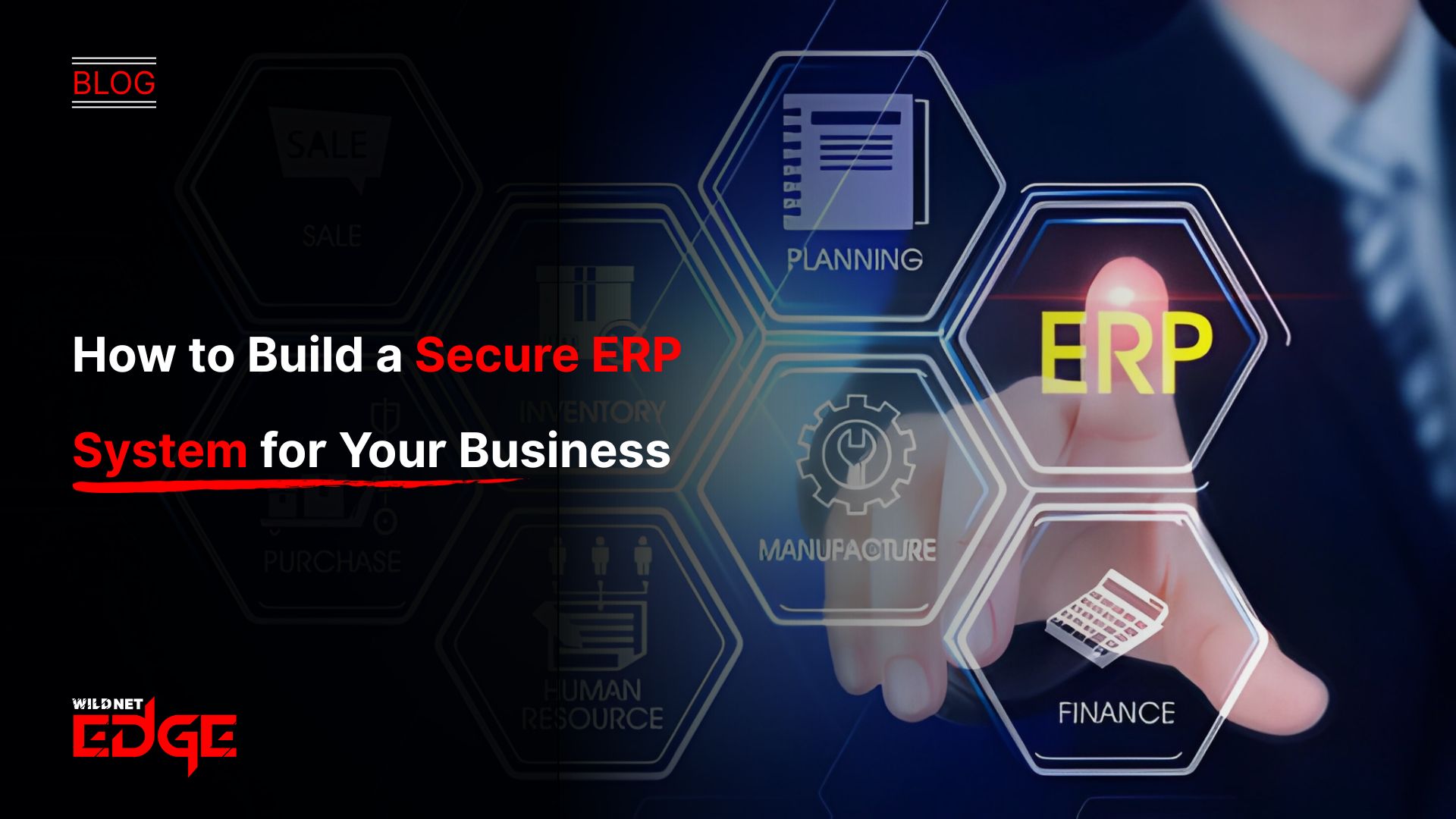TL;DR
This article highlights why building a secure ERP system is essential for modern enterprises. While ERPs centralize critical data, they also attract cyber threats—making robust security non-negotiable. It emphasizes secure architecture, encrypted data, strong access controls, and compliance through a Secure Software Development Lifecycle. Continuous monitoring and secure integrations are key pillars. The takeaway: investing in ERP cybersecurity from day one ensures data protection, resilience, and long-term business trust.
Imagine your business running like a perfectly tuned engine—finance, HR, and operations all connected through one powerful ERP system. Everything flows seamlessly… until one weak security link threatens to bring it all to a halt.
That’s where a secure ERP system changes the story. It’s not just software—it’s your digital fortress. Every transaction, every customer record, every insight is shielded by encryption, access controls, and constant monitoring. Because in today’s world, speed and integration mean nothing without safety. Building security into your ERP from day one isn’t just smart—it’s survival.
What is a Secure ERP System?
A secure ERP system is an enterprise resource planning platform that has been designed, built, and configured with a multi-layered security strategy at its core. Its goal is to protect the confidentiality, integrity, and availability of the critical business data it manages. This goes far beyond basic password protection. It involves a holistic approach that encompasses the application’s architecture, the code itself, user access policies, and the underlying infrastructure.
Why Enterprise Software Security is Non-Negotiable for ERPs
The results of a breach in your ERP can be very serious, and the downfall of a regular website hack cannot be compared to them at all.
- Operational Paralysis: A ransomware attack that encrypts your ERP can bring your whole business to a standstill from order processing to payroll.
- Massive Data Theft: A breach may give access to your organization’s whole financial statements, employee Personally Identifiable Information (PII), customer database, and even patents for the production process of your products.
- Financial and Reputational Ruin: The cost of remediation can be overwhelming, along with the regulatory fines (for instance, non-compliance with GDPR, SOC 2, etc.), and loss of customer and investor trust.
- Supply Chain Disruption: If your ERP system is hacked, the perpetrators might be able to infiltrate the connected supplier and customer systems.
The only way to avoid these risky situations is to have a proactive enterprise software security strategy in place.
Core Principles for Building a Secure ERP System
A robust ERP cybersecurity posture must be built in from the beginning, not bolted on as an afterthought.
1. Secure-by-Design Architecture
Security starts with the architectural blueprint. A secure ERP system must be designed with the principle of “defense in depth.”
- Role-Based Access Control: This is the most critical pillar. Employees should only have access to the specific data and functions absolutely necessary for their jobs. A sales rep, for example, should not be able to access payroll data.
- Data Encryption: All sensitive data must be encrypted, both “at rest” (in the database) and “in transit” (as it moves over the network).
- Network Segmentation: The ERP environment should be isolated in a secure network zone, with strict firewall rules controlling all traffic.
2. A Secure Software Development Lifecycle
How the code is written is just as important as the architecture. A secure SSDLC integrates security checks throughout the entire development process.
- Secure Coding Standards: Developers must be trained to avoid common vulnerabilities as defined by standards like the OWASP Top 10 e.g., SQL Injection, Cross-Site Scripting.
- Automated Security Testing: Integrate static (SAST) and dynamic (DAST) security testing tools into your CI/CD pipeline to catch vulnerabilities automatically before they reach production.
- Dependency Scanning: Automatically scan all third-party libraries used in your code for known vulnerabilities.
This rigorous process is a hallmark of high-quality ERP Software Solutions.
3. Robust Identity and Access Management
Controlling who logs in is your front gate.
- Multi-Factor Authentication: Enforce MFA for all users, especially administrators.
- Single Sign-On: Integrate your ERP with your corporate identity provider (e.g., Azure AD, Okta) to centralize and simplify user access management.
4. Meticulous Integration Security
Your ERP will connect to many other systems (CRM, eCommerce, banking). Each connection is a potential vulnerability. Secure APIs are essential for building a secure ERP system. All integrations must be authenticated, encrypted, and granted least-privilege access.
Custom ERP vs. Off-the-Shelf: A Security Tradeoff
When considering a new ERP, businesses face the build-vs-buy decision.
- Off-the-Shelf ERP: These vendors (like SAP, Oracle, NetSuite) invest heavily in security and compliance. However, their widespread use also makes them a large, well-understood target for attackers. You are also dependent on their patching schedules.
- Custom ERP: A custom ERP system has a unique codebase, making it an unknown target for attackers (security through obscurity, though not a complete strategy). More importantly, it gives you 100% control over your security architecture and compliance measures. This approach requires a highly skilled development partner.
Many businesses choose Custom Software Development Services to build a system that precisely matches their security and workflow needs.
Our Secure ERP Development in Action: Case Studies
Case Study 1: Securing Compliance, Powering Growth
- The Challenge: A manufacturing company in the aerospace sector needed a new ERP that could handle complex production workflows while adhering to strict ITAR and CMMC compliance regulations for data handling.
- Our Solution: We designed a secure ERP system from the ground up with compliance at its core. The architecture enforced strict data segmentation, implemented granular role-based access controls for sensitive design data, and built a comprehensive, immutable audit log for all system activities.
- The Result: The custom ERP passed all security audits, enabling the company to secure major government contracts. The robust ERP cybersecurity posture became a key competitive differentiator.
Case Study 2: Integrating Finance, Fortifying Security
- The Challenge: A growing retail chain’s existing accounting software couldn’t scale and didn’t integrate with their new inventory and POS systems, forcing manual, insecure data transfers.
- Our Solution: We built a custom financial module that integrated seamlessly with their other systems via secure APIs. The new module was built on a modern cloud platform and included automated workflows for reconciliation and reporting, a key way to Automate Business Processes.
- The Result: The company gained a real-time, unified view of its finances. The automated, secure data flow eliminated manual errors and closed significant security gaps, creating a more efficient and secure ERP system for their finance department.
Our Technology Stack for Secure ERP
We prioritize robust, enterprise-grade, and secure technologies.
- Backend: .NET, Java, Python
- Frontend: Angular, React
- Databases: Microsoft SQL Server, PostgreSQL, Oracle
- Cloud Platforms: Microsoft Azure, AWS
- Authentication: OAuth 2.0, OpenID Connect, SAML
- Security Testing: OWASP ZAP, SonarQube, Snyk
Conclusion
A secure ERP system is the single most important technical foundation for a resilient enterprise. While the initial investment in robust enterprise software security and ERP cybersecurity is significant, it is minuscule compared to the catastrophic costs of a breach. By building security into the DNA of your ERP’s architecture and development process, you create a platform that notS. Ready to build an ERP that is both powerful and secure?
At Wildnet Edge, our AI-first approach ensures we build intelligent, scalable, and resilient enterprise systems. We partner with you to create a custom ERP that protects your assets and powers your future.
FAQs
One of the most common and dangerous vulnerabilities stems from improper access control. This happens when employees are given overly broad permissions, allowing them to access or modify sensitive data (like financial records or payroll) that is not relevant to their job, increasing the risk of both insider threats and external attacks.
Both have pros and cons. Cloud providers offer world-class physical security and infrastructure monitoring, which is difficult for one company to replicate. However, on-premise gives you complete physical control. For most businesses, a well-configured cloud ERP is more secure, as it benefits from the provider’s massive, dedicated security resources.
A zero-trust model operates on the principle of “never trust, always verify.” It means that no user or device is trusted by default, even if it’s already inside the corporate network. Every access request to the secure ERP system is individually authenticated and authorized.
You should conduct automated vulnerability scans continuously as part of your development process. A comprehensive, third-party penetration test should be performed at least annually, or after any major changes are made to the system’s architecture or code.
Yes, this is a major trend. AI can be used to power anomaly detection systems that monitor user behavior. For example, it can flag a user logging in from an unusual location or trying to access large amounts of data at 3 AM, identifying potential account takeovers in real-time.
A modular architecture helps contain the blast radius of an attack. If one module is compromised, the isolation between services can prevent the attacker from easily moving to more sensitive modules, like the core financial ledger.
The first step is a comprehensive security audit and risk assessment. This involves reviewing all user access permissions, checking system configurations, and scanning for known vulnerabilities. You can’t secure what you don’t know is broken.

Nitin Agarwal is a veteran in custom software development. He is fascinated by how software can turn ideas into real-world solutions. With extensive experience designing scalable and efficient systems, he focuses on creating software that delivers tangible results. Nitin enjoys exploring emerging technologies, taking on challenging projects, and mentoring teams to bring ideas to life. He believes that good software is not just about code; it’s about understanding problems and creating value for users. For him, great software combines thoughtful design, clever engineering, and a clear understanding of the problems it’s meant to solve.
 sales@wildnetedge.com
sales@wildnetedge.com +1 (212) 901 8616
+1 (212) 901 8616 +1 (437) 225-7733
+1 (437) 225-7733































